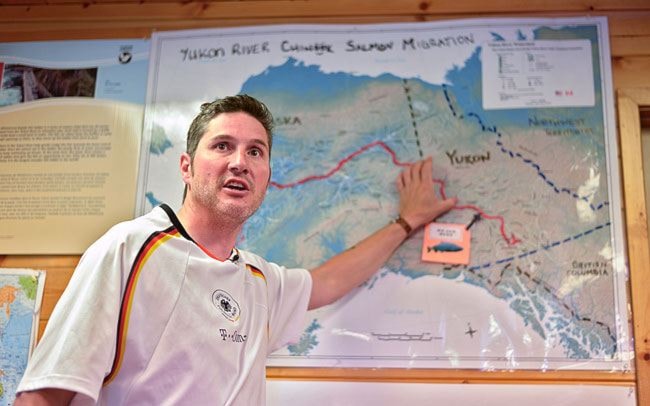On Thursday afternoon at the Whitehorse Fish Ladder, Dennis Zimmerman, executive director of the Yukon Salmon Sub-Committee, addressed managing the north’s dwindling chinook salmon population.
Zimmerman called it an unprecedented time in history.
“This is whole new regime with salmon management in the Yukon,” he said.
This year salmon numbers were expected to reach a historic low, and while they have improved - it is now estimated 120,000 chinook salmon will make the journey up the Yukon River - they are still dangerously low. In 1982, the salmon run peaked at around 300,000 fish.
“With chinook salmon, we’re unfortunately at a point that we have to manage them very tightly, because there’s not that many of them left.”
Each year, the chinook salmon embark on the longest freshwater salmon migration in the world.
They enter from the Bering Sea into Alaskan waterways and make their way to the spawning grounds on the border of B.C. and Yukon, traveling more than 3,000 kilometres. Along the way, they pass through communities that rely on them for food.
This year for the first time ever, Alaska instituted a ban against targeted fishing of chinook salmon.
Under treaty the Americans are required to allow 42,500 chinook to pass safely into Canadian waters. That goal has not been met in five of the last seven years.
“Alaska has a responsibility to get a certain number of fish to the border escapement, then Canada has a responsibility to get a certain number to the spawning grounds,” said Zimmerman.
Anything above that, Alaska and Canada can harvest and share those fish.
The targeted ban appears to have worked, for now, but not without coming at a cost.
“Taking away those rights, those subsistence rights is a very big deal and very difficult,” said Zimmerman.
“A lot of these villages don’t have roads, they don’t have grocery stores, gas is six bucks a gallon, it’s really expensive to live there, fishing is their right and if you take that away you cause a lot of hardship.”
Communities in the Yukon - like Teslin - have been voluntarily scaling back their fishing for about 10 years now and carrying the brunt of the conservation effort. The social and health impact on the communities is immense, said Zimmerman: “Generations losing fish camp culture, elders not being able to share practices with the youth, and losing all the nutrients out of their diets.”
Many First Nation communities, like the Tr’ondek Hwech’in and Selkirk First Nations, have resorted to flying non-native fish in.
Zimmerman said it’s a nerve-wracking and sombre time to be working in the industry - and that a solution isn’t imminent.
“Nothing is going to happen overnight, it’s going to take a few lifecycles to get these fish back,” he said.
“I think this year, everyone is on the same page. We have a commitment, a demonstrated commitment.”
Contact Sam Riches at
sam@yukon-news.com
